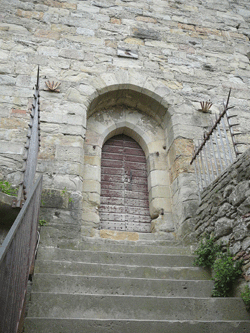Cathar Wars - Medieval Warfare - Gateways: Doors, Drawbridges,
Port Cullises, Postern Gates
Gateways, like all openings, were recognised weakpoints
in any defensive fortress. For this reason defenders tended
to take two simple precautions. The first was to minimise
the number of openings, including gateways. The second was
to provide additional defense for gateways.
The first was acheived by severely restricting the number
of gateways. Except for postern
gates, a typical castle would have only a single
entrance gate. Some had not at all - everthing that came
in did so by being hoisted up over the walls, and everything
that left did so be being thrown over the walls or hoisted
down. Towns would also have few gateways, often one, rarely
more than four, even for the largest cities.
The second method - protecting gateways - offered more
opportunities for imaginative solutions:
- obstacles - natural features
- obstables - the ditch & moat
- drawbridges
- obstacles - elevation
- obstacles - gates
- obstacles - flanking towers
- obstacles - the port cullis
- defensees - barbicans
- defences - meutriers (murder holes)
- defences - mazes & dead ends
- postern gates
Natural features.
|
Natural features than can provide defensive potential
include rivers, cliffs and marshland. In the Languedoc
the most common natural features used for defence
are mountains - massively exaggerated mottes.
The best known example is Montsegur
|
|
|
Ditches and Moats
|
Not all castles had moats. In fact not all even had
surrownding ditches.
The main purpose of moats was to keep siege engines
away from the walls, and also to prevent undermining.
|
|
|
Drawbridges
|
|
|
|
A
drawbridge at Carcassonne
|
|
|
|
Elevated doorways
|
The
White tower - The Keep (donjon) of the Tower
of London
|
|
|
|
Everyone knows about moats and drawbridges - but
not so many people know that most external doors in
castles were well above ground level.
This obviously made them more difficult to attack,
but how could they be used in peacetime? The answer
is that there were wooden structures providing access
for pedestrians, and sometimes for horses too.
You can see an outstanding example at the White tower
in the Tower of London, and a slighly less impressive
example at Montségur

|

|
Gates
|
Gates were made of wood, which made them vulnerable.
To maximise the strength they were made as thick at
practicable, often with layers of wood alternating
beween vertical and horizontal.
|
|
|
|
|
|
|
a
door in the Chateau Comtal at Carcassonne
|
|
|
|
Flanking towers
| Flanking towers provided the means to
house a number of defensive features including meutriers,
draw bridges, port cullises, etc |
|
|
|
|
|
|
|
|
A
portcullis at Carcassonne
|
|
|
|
|
The Port Cullis
|
    The
portcullis is a well known feature of castle and city
gates. The example on the left is from Puivert.
That on the right from Aigues
Mortes. The
portcullis is a well known feature of castle and city
gates. The example on the left is from Puivert.
That on the right from Aigues
Mortes.
The name means "running (ie sliding") gate.
Some were made in iron, some in wood. In the royal
badge now appropriated by the House of commons shown
above right, you can see the hoisting chains, usually
concealed from sight, here hanging loose.
The hoisting equipment, a geared windlas, is located
in the room above the gateway, which was often the
guardroom. It made sense to have your gards as near
as possible to the fortification's classic weakspot.
|
|
|
A
portcullis as Aigues Mortes
|
|
|
|
|
A
portcullis at Carcassonne
|
|
|
|
|
|
A
portcullis at Carcassonne
|
|
|
|
|
A
portcullis at Carcassonne
|
|
|
|
|
|
A
portcullis at Carcassonne
|
|
|
|
Barbicans
|
Barbicans are defensive structures controlling access
to a gateway.
There are spectacular examples at Carcassonne
- one at the main (Narbonne) Gate, shown on the right,
and another very differet one in the cite outside
the Cateau Comtal.
Click on the following link for more about Barbicans
|
|
|
Meutriers - "Murder Holes"
The
woman who threw the stone that killed Simon
de Montfort at Toulouse
|
|
|
|
Meurtiers were holes used to deliver death to attackers
- arrows, bolts, stones, heated sand, boiling water,
etc
Click on the following link for more about Meatriers
|
|
Meutriers
- Arrow loops or loopholes
|
|
|
|
|
|
Mazes and Dead ends
Postern Gates
|
|
|
|
A
Postern Gate at Carcassonne
|
|
|
|
|
|
 Back
to: the Papal Inquisition Back
to: the Papal Inquisition |

|
|
|
|



































